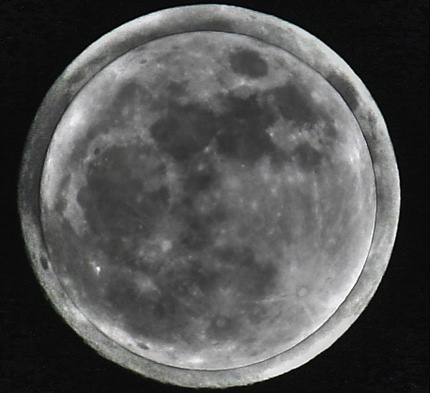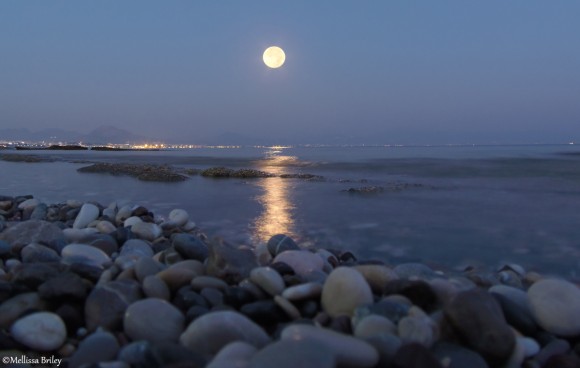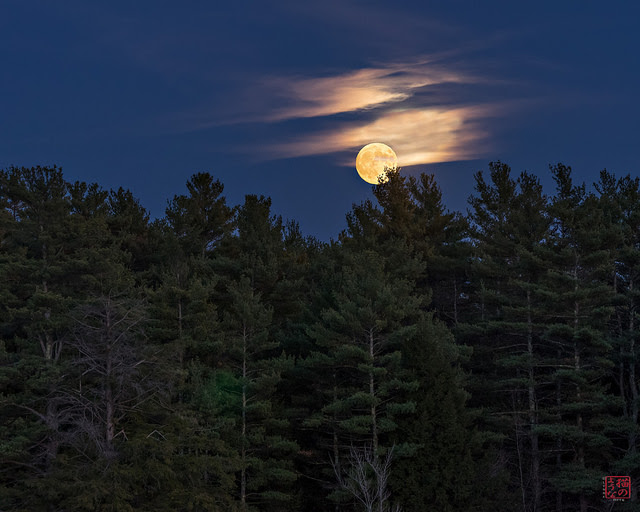
Tonight – October 15, 2016 – the Northern Hemisphere’s full Hunter’s Moon ushers in the first of this year’s three full-moon supermoons, that is, full moons near perigee, or the moon’s closest point to Earth for the month. The November and December full moons will qualify as supermoons, too.
The image at top shows a micro-moon (small full moon) superimposed on supermoon (large full moon). This image – an Astronomy Picture of the Day – is from Stefano Sciarpetti.
The size difference of year’s largest and smallest full moons is comparable to that of a U.S. quarter and a U.S. nickel.
Will your eye see that the moon is bigger on the night of October 15? Well … it depends. For one thing, this October full moon is not the year’s largest full moon. That’ll be next month’s full moon, on November 14.
Also, it’s hard to judge the full moon’s size in our sky from one month to the next. 2016’s smallest full moon, sometimes called a micro-moon, happened on April 22. Since then, each following full moon has been incrementally closer to Earth. To notice a size difference between the smallest moon of 2016 in April – and the October 15 supermoon – you’ll probably need photographs of both moons, or some other way to quantify the difference.
There’s another complication to consider. All full moons appear especially large when they’re close to the eastern horizon after sunset. This effect is known as the moon illusion.
Are you an incredibly careful observer? Have you watched the full moon over a period of months, leading up to now? If so, says Daniel Fischer in Königswinter, Germany, you can discern the extra-large size of the supermoon using just your eye. Read Daniel’s article on this subject.
The ancients were well aware of the moon’s changing angular diameter and its varying distance from Earth. That’s because ancient astronomers used a diopter to directly measure the moon’s apparent diameter.
The November 14, 2016 full moon – closest and largest full moon is 2016 – will also be the largest full moon thus far in the 21st century (2001 to 2100). It’ll be the closest encounter between the Earth and moon until November 25, 2034! Read more about the November 14 supermoon.
Enjoying EarthSky so far? Sign up for our free daily newsletter today!

Details on the October 2016 full supermoon The full moon falls at the same instant all over the world: October 16 at 4:23 Universal Time.
Clock time for this full moon – and every full moon – varies by time zone. For London, the moon turns full at 5:23 a.m. BST on October 16, at which time the moon shines in their western sky. For the U.S., the moon turns full on October 16 at 12:23 a.m. EDT – yet on October 15 at 11:23 p.m. CDT, 10:23 p.m. MDT and 9:23 p.m. PDT.
Technically speaking, the moon turns full at the instant that the moon lies opposite the sun for the month in ecliptic longitude. Because the moon stays more or less opposite the sun throughout the night, watch for a full-looking moon in the east at dusk, highest in the sky around midnight and low in the west at dawn. On the nights immediately before and after full moon, the moon still looks plenty full to the eye.
When is perigee, the moon’s closest point to Earth? In October 2016, the moon’s perigee comes about 19 hours after full moon, on October 16 at 23:36 Universal Time.
The close coincidence of full moon and perigee makes this October full moon a supermoon.
By the way, no particular effects are expected from this extra-close full moon … unless you have the mass of an ocean! In that case, gravity will come into play. In other words, because it’s a supermoon, and relatively close to Earth, this month’s full moon will pull harder than usual on Earth’s oceans. Expect higher-than-usual tides to follow this full moon by a day or so.

In the Northern Hemisphere, we call the full moon immediately following the Harvest Moon a Hunter’s Moon. This October 15, 2016 moon is the Northern Hemisphere’s Hunter’s Moon. Read more about the Hunter’s Moon here.
Enjoy moon-watching tonight and Sunday night!


Bottom line: The full moon on the night of October 15-16 ushers in the first of three full-moon supermoons in 2016. Full moon is October 16, 2016, at 4:23 Universal Time. The moon’s perigee or closest point comes on October 16, at 23:36 Universal Time.











